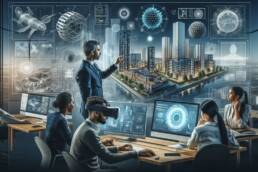The future of architecture is being significantly shaped by advancements in 3D visualization. As the industry embraces these technologies, project planning and client engagement are undergoing a transformation. 3D visualization not only enhances the design process but also streamlines decision-making and expands the realm of architectural possibilities. This article explores the pivotal role of 3D visualization in modern architecture and its impact on the evolution of project planning, the synergy of technology and creativity, and the expansion of architectural boundaries.
Key Takeaways
- 3D visualization is revolutionizing architectural design by enabling photorealistic renderings and virtual prototypes that enhance client engagement and communication.
- The use of interactive 3D models and virtual reality is opening new frontiers in client presentations, allowing for immersive experiences and real-time modifications.
- Advanced software, combined with the expertise of skilled artists, is driving the creation of detailed and accurate representations of architectural concepts.
- Sustainable architecture is benefiting from 3D visualization, which facilitates environmental analysis and informed decision-making in the early stages of design.
- The global reach of 3D visualization is expanding the boundaries of what is possible in architecture, overcoming complex challenges with precision and creativity.
Revolutionizing Design with 3D Visualization
1. The Role of 3D Rendering in Modern Architecture
In our architectural practice, we’ve embraced the transformative power of 3D rendering. This technology has become an indispensable tool, allowing us to create three-dimensional, photorealistic images from our designs using sophisticated software. The ability to visualize the finished product realistically, long before construction begins, has revolutionized how we approach design and planning.
3D rendering services are the backbone of any architectural visualization project, transforming basic sketches into lifelike images. These services enable us to help clients see the real potential of their projects, whether it’s a residential home or a commercial building. The images produced are not just tools; they bridge imagination and reality, detailing everything from spatial layouts to the interplay of light and shadow.
Our experience with visualization experts has been overwhelmingly positive. Their ability to manage schedules, communicate intent, and deliver high-quality renderings has made them invaluable partners in bringing our visions to life.
The benefits of 3D visualization for architects are numerous and significant. Here’s a brief list highlighting some of these advantages:
- Enhanced communication with clients and stakeholders
- Improved accuracy in design and planning
- Efficient revisions and decision-making
- Effective marketing and project showcasing
By understanding the current benefits and future directions of 3D rendering, we can continue to harness these tools to their fullest potential in our projects.
2. Enhancing Client Engagement and Communication
We’ve witnessed firsthand the transformative power of 3D visualization in enhancing client engagement and communication. Clients are no longer passive observers; they become active participants in the design process. With the ability to visualize projects in three dimensions, clients can better understand and articulate their preferences, leading to more effective collaboration.
Feedback is crucial in shaping the outcome, and 3D visualization tools have streamlined this process. Here’s how:
- Clients can provide immediate reactions to designs.
- Changes can be made in real time, saving valuable time and resources.
- Visualization is a common language, bridging the gap between technical jargon and client understanding.
By immersing clients in the virtual representation of their project, we foster a deeper connection and commitment to the vision we’re building together. This not only improves satisfaction but also minimizes the risk of costly post-construction changes.
3. From Concept to Reality: The Impact of Photorealistic Imagery
We’ve witnessed a paradigm shift in architectural visualization with the advent of photorealistic imagery. The world of computer-generated imagery (CGI) has transformed architectural design and visualization. With advanced 3D rendering services and software, we can now present a building’s design in its full glory before the first stone is set.
The ability to experiment with lighting, textures, and materials in a virtual environment has revolutionized the way we communicate design intent and aesthetics.
Photorealistic renders bridge the gap between conceptual sketches and the final built form, allowing clients to visualize the result with stunning clarity. This not only enhances client engagement but also streamlines the approval process. Here’s how CGI impacts our workflow:
- Enables detailed exploration of design options
- Facilitates better understanding of spatial relationships
- Allows for early detection and correction of potential issues
- Provides a powerful marketing tool for pre-sales
By integrating CGI into our practice, we ensure that our designs are not just seen, but felt and experienced, even before construction begins.
The Evolution of Project Planning through 3D Models
1. Streamlining Decision-Making with Virtual Prototypes
We’ve embraced the power of virtual prototypes to transform the way we make decisions in architectural projects. By creating detailed 3D models, we can explore various design options and foresee potential issues before any physical construction begins. This proactive approach not only saves time but also significantly reduces costs associated with on-site errors and delays.
Virtual prototypes serve as a bridge between imagination and reality, allowing clients and stakeholders to experience the space as if it were already built. Our process includes several key steps:
- Initial concept visualization
- Iterative design refinements
- Integration of feedback from all parties
- Finalization of the design for construction
The clarity provided by these 3D renderings ensures that everyone involved has a shared understanding of the project, streamlining communication and collaboration.
With the aid of Artificial Intelligence or AI, we’re pushing the boundaries even further. Architects now leverage immersive VR experiences to present designs, enabling clients to navigate virtual spaces and make informed decisions. This integration of technology and creativity is not just a trend; it’s the new standard for architectural excellence.
2. Interactive 3D Models: A New Frontier in Client Presentations
We’ve embraced the transformative power of interactive 3D models, recognizing them as a game-changer in client presentations. These models allow clients to explore and interact with the design in real time, fostering a deeper understanding and connection to the project. Clients can now experience the space as if they were physically present, turning abstract concepts into tangible experiences.
Interactive 3D models and animated walkthroughs provide an immersive view of spaces, making it easier to market properties attractively for both residential and commercial projects. This level of engagement was previously unattainable with traditional 2D blueprints and renders.
By incorporating interactive elements into our presentations, we ensure that clients are not just passive observers but active participants in the design process.
The benefits of using interactive 3D models in presentations are numerous:
- Enhanced client understanding and satisfaction
- Immediate feedback leading to quicker revisions
- A more collaborative and dynamic design process
Our commitment to leveraging the latest in visualization technology positions us at the forefront of architectural innovation, ready to tackle the challenges of tomorrow.
3. Incorporating Environmental Analysis in Early Design Stages
We recognize the growing importance of sustainability in architecture. By integrating environmental analysis into the early stages of design, we can explore eco-friendly materials and energy-saving designs. This proactive approach allows us to address environmental concerns from the outset, ensuring that our projects contribute positively to their surroundings.
The use of 3D visualization tools enables us to simulate various environmental conditions and assess the impact of our designs before any physical construction begins. We can model different scenarios, such as sunlight and shadow patterns, wind flow, and thermal performance, to optimize the building’s environmental responsiveness.
Our commitment to sustainability is reflected in our design process, where we prioritize the reduction of waste and the conservation of resources.
By incorporating these analyses, we not only create buildings that are more efficient and comfortable for occupants but also reduce long-term operational costs. The table below illustrates the benefits of early environmental analysis in our projects:
| Aspect | Benefit |
|---|---|
| Energy Efficiency | Improved building performance |
| Material Optimization | Reduced waste and costs |
| Occupant Comfort | Enhanced living and working environments |
The Synergy of Technology and Creativity
1. Advanced Software and Skilled Artists: A Potent Combination
We harness the synergy of advanced software and the creativity of skilled artists to push the boundaries of architectural visualization. The precision and artistry that our team brings to each project are unparalleled, thanks to the sophisticated tools at our disposal. Our commitment to excellence is evident in the photorealistic renderings we produce, which are not just visually stunning but also technically accurate.
- Advanced 3D rendering software
- Expert team of 3D artists
- Commitment to photorealism and accuracy
By blending cutting-edge technology with artistic flair, we create visualizations that are not only impressive in their realism but also in their ability to convey the architect’s vision.
The feedback from our clients, such as CG Viz Studio, attests to the transformative impact of our services. They have experienced firsthand how our visualizations bring their designs to life, facilitating better communication and decision-making. As we continue to innovate, we remain focused on providing high-end 3D visualization services that revolutionize architectural design and planning.
2. Real-Time Modifications and Iterative Design
We’ve embraced the evolution of 3D modeling as a pivotal force in revolutionizing architecture. The agility to make real-time modifications during the design phase has become a cornerstone of our practice. This iterative approach to design ensures precision and client satisfaction before a single stone is laid.
The immediacy of 3D visualization technology allows for a dynamic design process, where feedback can be integrated instantly, fostering a collaborative environment between architects, clients, and stakeholders.
The benefits of this methodology are clear:
- Enhanced design accuracy
- Reduced risk of costly post-construction changes
- Improved client engagement
By harnessing the power of visualization tech, we’ve not only enhanced the design process but also expanded architectural imagination, unlocking endless innovation potential. The integration of VR and AR is shaping the future, where the boundaries of what can be envisioned are continually being pushed.
3. The Future of Sustainable Architecture with 3D Visualization
As we embrace the future of sustainable architecture, 3D visualization plays a pivotal role in shaping eco-conscious designs. By simulating real-world conditions, architects can now meticulously plan and optimize buildings for energy efficiency and minimal environmental impact. 3D visualization architecture allows for the experimentation with eco-friendly materials and designs at the conceptual stage, ensuring the best sustainable practices are integrated from the outset.
The synergy between advanced visualization tools and sustainable design principles is revolutionizing the way we approach architecture. It empowers us to create spaces that are not only aesthetically pleasing but also kind to our planet.
The benefits of incorporating 3D visualization in sustainable architecture are manifold. Here’s a brief overview:
- Energy Modeling: Simulate and analyze energy consumption to improve efficiency.
- Material Selection: Experiment with various eco-friendly materials to find the most sustainable options.
- Sunlight Analysis: Optimize natural lighting to reduce reliance on artificial sources.
- Water Management: Design landscapes and features that enhance water conservation.
Expanding the Boundaries of Architectural Possibilities
1. Tackling Complex Architectural Challenges with Precision
As we embrace the future of architecture, we find ourselves at the forefront of a transformative era where 3D visualization plays a pivotal role in addressing complex architectural challenges. The synergy between Design for Manufacture and Assembly (DfMA) and 3D rendering has become a cornerstone in our practice, enabling us to bring to life intricate designs that were once considered unattainable.
The precision afforded by 3D rendering allows us to anticipate and resolve potential construction issues before they arise, ensuring a seamless transition from design to assembly. This proactive approach not only enhances design efficiency but also significantly reduces the risk of costly on-site errors.
Our commitment to innovation is reflected in our workflow, which integrates the following key steps:
- Meticulous planning and environmental analysis at the early stages
- Detailed 3D modeling of complex geometries
- Photorealistic rendering for clear visualization
- Virtual prototyping for design validation and optimization
The feedback we’ve received from clients and industry experts alike underscores the transformative impact of 3D visualization. One of the biggest benefits highlighted is the ability to create incredibly detailed 3D interior and exterior renderings, which are instrumental in our pursuit of precision and excellence.
2. Virtual and Augmented Reality: The Next Steps in Visualization
As we embrace the future of architectural visualization, VR and AR technologies are at the forefront, offering immersive experiences that are revolutionizing our industry. Clients can now explore virtual models with VR, or overlay new designs onto existing spaces using AR, providing a level of interaction and realism previously unattainable.
Immersive experiences are not just a novelty; they are becoming essential tools in our design process. Here’s how they contribute to our work:
- Allowing clients to ‘walk through’ their future spaces
- Enabling real-time environmental simulations
- Facilitating a better understanding of spatial relationships
By integrating VR and AR into our workflow, we enhance decision-making and optimize design, ensuring that every project benefits from the highest level of precision and client satisfaction.
These technologies not only aid in visualizing spaces but also in communicating complex architectural ideas effectively. As we continue to explore the potential of VR and AR, we remain committed to pushing the boundaries of what’s possible in architectural visualization.
3. The Global Reach of 3D Visualization in Architecture
As we embrace the digital era, 3D visualization has become a cornerstone in architectural design, transcending geographical boundaries. The global impact of this technology is undeniable, allowing architects and clients to collaborate seamlessly, regardless of location. With the advent of online platforms and cloud-based tools, sharing and reviewing complex 3D models has never been easier, fostering a new level of international cooperation.
The benefits of 3D visualization are not confined to a single region; they are experienced worldwide. Here’s a glimpse into how various countries are leveraging this technology:
- In the United States, firms are utilizing 3D visualization to engage stakeholders and secure project approvals swiftly.
- European architects are pioneering sustainable design practices by integrating 3D environmental analysis into their workflows.
- Asian markets, known for rapid urbanization, are employing 3D models to plan and execute large-scale developments efficiently.
The democratization of 3D visualization tools has led to a surge in creativity and innovation across the globe. It empowers professionals to push the boundaries of what’s possible, ensuring that the final structures are not only aesthetically pleasing but also functional and sustainable.
As we look to the future, the reach of 3D visualization will only continue to expand, revolutionizing architectural projects with high-tech tools, and enhancing speed, quality, and collaboration. The market demands cost-efficiency, innovation, and user-friendly interfaces for real-time marketing and HD viewing. This is just the beginning of a new chapter in architecture, where the virtual and the real converge to create spaces that were once mere figments of our imagination.
At the forefront of innovation, we at CG Viz Studio are constantly pushing the envelope, expanding the boundaries of architectural possibilities with our state-of-the-art 3D visualization services. Our portfolio is a testament to the creativity and precision that we bring to every project. Whether you’re an architect, developer, or designer, we invite you to explore our gallery and see the potential of your next project come to life. Don’t just imagine the future; let us help you create it. Visit our website to start your journey towards groundbreaking designs.
Get your project estimated within 60 minutes - simply send us your project brief!
Conclusion
As we have explored throughout this article, 3D visualization stands as a transformative force in the realm of architecture and project planning. Companies like CG Viz Studio are at the forefront of this revolution, offering advanced 3D rendering services that bring architectural concepts to life with stunning realism. The testimonials from satisfied clients across the globe underscore the value and impact of these visualizations in enhancing understanding, improving decision-making, and streamlining the project development process. The future of architecture is undeniably intertwined with the continued evolution of 3D visualization technologies, promising even more sophisticated tools for architects, developers, and investors to visualize and execute their visions with unprecedented clarity and efficiency.
Frequently Asked Questions
3D architectural visualization is the process of creating digital models of buildings or spaces before they are built, using advanced software to generate realistic images or animations. It benefits project planning by providing a clear preview of the construction, enhancing decision-making, and aiding in the promotion of projects to potential buyers or investors.
Yes, 3D visualization is particularly effective in addressing complex architectural challenges. It allows for precise modeling of intricate details and complex geometries, enabling architects to push the boundaries of creativity and ensure that innovative designs are feasible.
CG Viz Studio enhances client engagement by providing high-quality, photorealistic renderings and animations that allow clients to visualize their projects clearly. This level of detail and realism in the visualizations facilitates better communication and helps clients make informed decisions.
CG Viz Studio offers a range of 3D visualization services including architectural visualization, 3D rendering and animation, 3D interior and exterior visualization, 3D product visualization, and more. They specialize in creating accurate and engaging visual content for various industries.
You can access CG Viz Studio’s selection of high-quality 3D models and other resources by visiting their online shop at https://www.cgvizstudio.com/shop/. The shop offers a variety of 3D assets, including architectural elements and tileable textures, suitable for different design projects.
Future advancements in 3D visualization for architecture may include the use of virtual and augmented reality for immersive walkthroughs, interactive 3D models for hands-on experiences, and enhanced environmental analysis for sustainable design. These technologies will continue to transform project planning and design practices.



